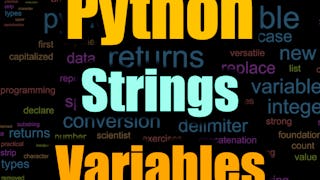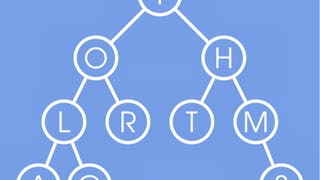In this course, you'll explore loops, which repeat a portion of code until a process is complete. You’ll learn how to work with different kinds of iterative or repeating code, such as for loops and while loops. Then, you'll explore strings, which are sequences of characters like letters or punctuation marks. You’ll learn how to manipulate strings by indexing, slicing, and formatting them.


您将学到什么
How to manipulate strings using techniques such as concatenating, indexing, slicing, and formatting
Purpose and logic of iterative statements such as for loops and while loops
Be able to summarize the syntax of the range() function
您将获得的技能
要了解的详细信息

添加到您的领英档案
September 2025
4 项作业
了解顶级公司的员工如何掌握热门技能

积累特定领域的专业知识
- 向行业专家学习新概念
- 获得对主题或工具的基础理解
- 通过实践项目培养工作相关技能
- 获得可共享的职业证书

该课程共有4个模块
You'll explore loops, which repeat a portion of code until a process is complete. You’ll learn how to work with different kinds of iterative or repeating code, such as while loops.
涵盖的内容
3个视频1篇阅读材料1个作业3个非评分实验室
You'll explore for loops, another kind of iterative or repeating code.
涵盖的内容
2个视频1篇阅读材料1个作业2个非评分实验室
You'll explore strings, which are sequences of characters like letters or punctuation marks. You’ll learn how to manipulate strings by indexing, slicing, and formatting them.
涵盖的内容
3个视频2篇阅读材料1个作业2个非评分实验室
Review everything you’ve learned and take the final assessment.
涵盖的内容
1篇阅读材料1个作业
获得职业证书
将此证书添加到您的 LinkedIn 个人资料、简历或履历中。在社交媒体和绩效考核中分享。
位教师

提供方
从 Data Analysis 浏览更多内容

Coursera Project Network

Coursera Project Network
 状态:免费试用
状态:免费试用University of California San Diego
 状态:免费试用
状态:免费试用
人们为什么选择 Coursera 来帮助自己实现职业发展




常见问题
Organizations of all types and sizes have business processes that generate massive volumes of data. Every moment, all sorts of information gets created by computers, the internet, phones, texts, streaming video, photographs, sensors, and much more. In the global digital landscape, data is increasingly imprecise, chaotic, and unstructured. As the speed and variety of data increases exponentially, organizations are struggling to keep pace.
Data science is part of a field of study that uses raw data to create new ways of modeling and understanding the unknown. To gain insights, businesses rely on data professionals to acquire, organize, and interpret data, which helps inform internal projects and processes. Data scientists rely on a combination of critical skills, including statistics, scientific methods, data analysis, and artificial intelligence.
A data professional is a term used to describe any individual who works with data and/or has data skills. At a minimum, a data professional is capable of exploring, cleaning, selecting, analyzing, and visualizing data. They may also be comfortable with writing code and have some familiarity with the techniques used by statisticians and machine learning engineers, including building models, developing algorithmic thinking, and building machine learning models.
Data professionals are responsible for collecting, analyzing, and interpreting large amounts of data within a variety of different organizations. The role of a data professional is defined differently across companies. Generally speaking, data professionals possess technical and strategic capabilities that require more advanced analytical skills such as data manipulation, experimental design, predictive modeling, and machine learning. They perform a variety of tasks related to gathering, structuring, interpreting, monitoring, and reporting data in accessible formats, enabling stakeholders to understand and use data effectively. Ultimately, the work of data professionals helps organizations make informed, ethical decisions.
We highly recommend taking the courses in the order presented, as the content builds on information from earlier courses. This is the third course in a series of six courses that make up the Google Data Analysis with Python Specialization.
更多问题
提供助学金,

 中
中

